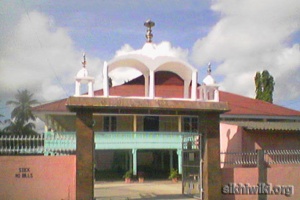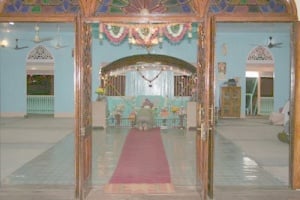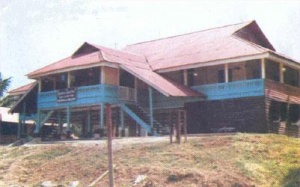Gurdwara Shaheed Dr. Diwan Singh
A Gurdwara dedicated to a Noble Man
Perhaps, this is the first and last Gurdwara, named after a person other than the Sikh Gurus.
Gurdwara Dr. Diwan Singh is a Sikh shrine located in the heart of Port Blair in the Andaman Islands. This Gurdwara was established in 1937 by Dr. Diwan Singh Kalapani a well known independence martyr. This Gurdwara is built with wood on a foundation of iron pillars. This is one of the oldest Gurdwaras in Port Blair. The Gurdwara is in the Aberdeen Bazaar and caters to the Punjabi community of the Andaman and Nicobar Islands.
Brotherhood
The Gurdwara's foundation was laid by the local Panj Piare on 1st August 1937, at first it was refered to simply as the "New Gurdwara". The whole community of Port Blair, that's right--not just the Sikhs!, but citizens - whether Christian, Hindu or Muslim, joined the five respected Sikhs and their Sikh brothers and Sisters in the building of the Gurdwara. Practically everyone who lived in Port Blair devoted their time, energy and resources to complete this 'New Gurdwara'.
Even the Military Police denoted a sum of Rs. 500/- towards the construction fund.
Unique System of Management
The 'New Gurdwara' was run by a unique Committee consisting of 25 members from all faiths. It included 12 Sikhs, 10 Hindus, 2 Muslims and 1 Christian.
To recognize the sacrifice made by Dr. Diwan Singh `Kalepani" for the sake of `Truth and Righteousness, the `New Gurdwara, at Aberdeen', Port Blair was renamed in his honor on 27.11.1948 by a notice no. 89 dated 06.12.1948 signed by Sardar Bakhtawar Singh, the Honorary Secretary of Gurdwara Doctor Diwan Singh. This august decision was announced in the Sangat by Sardar Mohan Singh ji, the then Jathedar of the Akal Takhat. The Jathedar was on an official visit to the Islands as chairman of a delegation.
A brief history and a personal visit
There is a relatively large Sikh community living in the Island. I called at this place in 1979 when there were about two thousand Sikhs were in the area. It is very much like the Indian mainland. Apart from those who live here there are always Sikh officers and army naval personal posted on the Island. There has been a Sikh presence in the islands from about 1925.
In the early days, up until about 1960s,(1965) ships sailing from Penang, Malaysia to Kolkatta (Calcatta), often called in Port Blair. A large garrison of Sikhs was stationed there in WWII.
A Little Known Atrocity
Some of atrocities and massacres carried out by the Germans and Japanese are well known while others are all but forgotten--or worse never even heard of. Hitler and the Nazis; Il Duce and the Blackshirts and General Tojo (Some even now say that Hirohito was not as innocent as claimed) and the Japanese Military were guilty of some of the worse atrocities of human history. Millions upon millions of innocent men, women and children died from their 'new weapons and modern ways of war.
Historians and Allies have well recorded what happened in Europe during World War II. The slaughter of: the French in Oradaur-sur-Glane; of the Czechs of Lidice (even their town was destroyed); of the Jews, Gypsies, mentally ill and homosexuals--the Communists never even made it to Auschwitz, Buchenwald, Ravensbruck and many more; the Syrians at Hama and the Palestinian massacre in Lebanon are well known all over the world. Even though today there are many who discount them, saying they either never happened or were overblown.
I feel, however that history has failed to do justice to the atrocities that occurred in the East and South-East Asia.
Many people are not aware of the Japanese brutalities at Manchukuo, Chahar, Hopeh, Tientsin, Shanghai, Nanking, the Philippines, Malaya, Singapore, Burma and particularly those of the Andaman and Nicobar Islands.
For Asians, World War II started in 1931 with the staged railroad incident of the Imperial Japanese Army who then occupied South-East Manchuria; for Africans the war started in 1935 when the modern aircraft of Il Duce attacked the spear armed tribesmen of Abyssinia with bombs and machine guns; for Europeans WWII started in 1939 after many appeasments to Mr. Hitler and for the Americans all of the long resistant to losing sons in another 'European war ended suddenly with the sneak attack on Pearl Harbour on December 7, 1941.
For the Chinese, the 1930s were most terrible as they suffered humiliation and horrors at the hands of people whom they considered to be decendeants of their ancestors. Though the Japanese had long admired and imitated Chinese ways, religion and customs their desire to compete with the western powers produced a change of attitude--where they treated the Chinese as little more than primative animals who had the resources and land that the Japanese now coveted and stole. The Chinese endured the worst tortures that the Japanese soldiers could dream up in their indescribable ruthlessness.
The story of China, particularly that of Nanking, would have gone into oblivion but for a few Americans and Europeans who were witnesses to crimes committed by the Japanese. A number of Chinese too survived to relate the story of woe. Iris Chang, a Chinese American, author of "The Rape of Nanking", is a living legend who has courageously unfolded this tragic tale. Her book, I’m sure, will survive as a classic among the annals of history — a marvellous contribution to the culture, heritage and civilisation of China. The movie "The Rape of Nanking" is now even serialized on youtube.
The Author's Thoughts
There is a big question mark in my mind, as to why the rape of Nanking, the Bataan march in Manila and the massacre of Port Blair in the Andaman Islands failed to stir the consciousness of mankind. In my opinion its roots lie in global politics.
I feel that the Japanese culture will remain stagnant until it apologises to the countries it conquered. The story of the Japanese carnage in the Andaman and Nicobar Islands is altogether different. It is unknown and not taught in any Japanese texts and the government is indifferent to this important event of history.
The chain of these islands is situated in the Bay of Bengal about 780 miles from Calcutta, 740 miles from Madras and 120 miles from Cape Nargis in Burma. Like the Pentoville prison at Port Arthur, the British colonised these islands, using them for the imprisonment of criminals as well as many freedom fighters who opposed their rule of India.
Details of the, all too human, slaughter of innocent, unarmed Indians at Port Blair may stimulate academicians and research scholars to make a fresh appraisal of the freedom movement of India.
Japanese Invade Andaman
Twenty thousand Japanese soldiers landed at different places in South Andamans on March 23, 1942. There was no resistance from the local population and within three hours the Japanese were in complete control of the islands. A big crowd gathered at the jetty to welcome them. The Japanese immediately put the welcoming committee to work unloading arms, ammunition and stores. That same afternoon a different group of soldiers pounced, like hungry wolves, on shops looting everything they could lay their hands on. Some of the groups entered the most populous area of Aberdeen and indulged in looting and taking liberties with the women. The inmates of the Island looked at them helplessly with dazed eyes. The oppressive and most undignified behaviour of the Japanese stunned the Indians who never expected such misconduct from the Japanese, who had popularized the slogan of of a free South-east Asia.
A young man named Zulfikar Ali picked up his BB gun and fired a few shots in the air to scare them away. The Japanese ran away but came back soon with a large armed force and laid siege to the town. In the meantime Zulfi, as he was called, somehow escaped to another area to avoid the Japanese wrath. They ransacked the whole town and assaulted some women and young girls. They demanded that the villagers produce the boy the next morning or the whole village would have to face consequences. Leaving for the night they set fire to a wooden house, soon the rising flames engulfed several nearby houses, they too were all made of wood.
The Islanders look to Dr. Diwan Singh
A few responsible people approached the man they looked to as their leader, Dr. Diwan Singh Kalepani, asking for his advice. He told them to produce the boy next morning. Early next morning, six Japanese soldiers dragged the boy in front of the villagers where he was beaten, kicked and fiercely thrashed till he was unconscious. Then they lifted this seemingly lifeless boy, broke his bones, crushed his joints and then used him as the target of a bayonet charge.
Today his grave in Port Blair stands as a reminder for the islanders of the butchery of the Japanese soldiers who had come speaking of friendship and liberation. Seeking to soothe the unsettled Islanders, a few days later, the Japanese charged A. G. Bird, a British POW, on the charge of spying. The same drill was repeated ending with his body being cut into small pieces and left unburied for animals to eat. His severed head was hung on a tree. In a daring move, Diwan Singh and Sebastian Pinto (an assistant to the doctor) collected A. G. Bird’s remains and gave him a decent Christian burial. The Japanese took serious offence to this.
To strengthen their hold, a civil government was established. A Governor was appointed who was to be assisted by the Vice-Admiral. Meanwhile the Japanese soldiers indulged in the rape and abduction of women. The soldiers in liaison with civil police would enter the houses of the people and forcibly rape women--even young boys were used to satisfy the soldiers' lust. The Japanese surpassed the stories of Halaku and Chengiz Khan in deriving pleasure from unbelievable orgies they engaged themselves in. The conditions in the villages situated in the hinterlands became so pathetic that a number of locals became collaborators to gain favours from the unscrupulous Japanese.
"Ros Jageyo" Diwan Singh
Diwan Singh, the healer of the people, was their only ray of hope. He, as Director, Health, President of the Indian Independence League, the Indian National Army, peace committee and the Seva Samiti met with the new Governor every day seeking some relief of populations misery. This eventually provoked the Japanese police and administration so much, that with the help of local collaborators they started poisoning the ears of the Governor. Never the less, Diwan Singh continued to serve his people undeterred.
To further strengthen their hold, and prove their ruthlessness, the Japanese arrested eight high-ranking Indian officials, who the islanders considered to be very close to the Japanese, in the second spy case in October, 1943. They were tortured and beaten for a number of days to extract false confessions. After they confessed, they were starved and taken to an isolated place. They were forced to dig a trench and buried alive up to the waist. The soldiers then stabbed them in their eyes, head and torsos with their bayonets, then they sprayed bullets till they were sure of their deaths. Diwan Singh then lodged a strong protest with the Governor and the Vice-Admiral. To silence him the peace committee was dissolved.
Diwan Singh Arrested
Diwan Singh was arrested on October 23, 1943. On entering the jail, he was jeered, abused and beaten mercilessly. In a week’s time, all of his 2000 associates who were the members of the peace committee, the IIL, the INA, the Seva Samiti and the Punjabi Society, were also arrested and huddled in the jail. The Japanese beat and used their water torture, electric shocks, hung them upside down, and burned heaps of paper under their thighs. A very large number of them died, some committed suicide and a few made false confessions to save their lives. They were taken to a remote place, where they were killed and buried.
82 days of Torture lead to the Doctors death
Diwan Singh was brutally tortured for 82 days, a parallel of which is difficult to find in history. He was hung by his hair from the ceiling. Alternately, his ankles were tied to the ceiling while water was pumped through his mouth and nostrils, he was tied to a stake as his bones were crushed—even electricity was used. Unbelievably, fires was lit under his thighs; nails pulled from his fingers and toes. Strips of flesh were peeled from various parts of his body daily. He was even forced to sit on a charcoal stove. Though they ended his torture by gouging out his eyes the Japanese were never able to break the Doctor's spirit. He died on January 14, 1944.
Reign of terror
After his death the Japanese let loose a reign of terror. Young girls and women were forcibly taken to the officers’ club to 'give comfort' to the Japanese elite and army officers. A shipload of Korean girls was also brought to the island as so called 'comfort girls' for even the soldiers of low or no rank.
It was a free for all. Men, women and children were shot dead or hacked by sword for no reason, the days of the wild Samurai, who had the power of life and death had returned--to the wrong Island.
In the first week of June, 1945, hundreds of educated families were lodged in the cellular jail on a false promise that they were to be taken to a virgin soil to lead a comfortable life. They were boarded on a number of transport aircraft. On sighting the Havelock Island, situated at a distance of 50 miles from Port Blair, they were ordered to jump in the sea. Whoever hesitated was beaten with rifle butts while others were struck with swords and bayonets. Out of 1,500, about 250 swam ashore only to die of hunger and starvation. In a fortnight half of them died; the rest were struggling to survive on the leaves and bark of trees, as the soil was saline and unproductive. In the end only one person by the name of Mohammad Saudagar survived to tell their story of woe.
Within a week of this cold-blooded massacre the Japanese chased about 900 people from several villages and gathered them in a central village to 'facilitate their transportation' to a nearby island. After keeping them hungry for 24 hours they were taken to Tarmugli Island where they were all tied to trees and used for bayonet practice. Petrol was sprinkled over them and the dead were burned to ashes along with some who were burned alive.
More than 2,000 people were crammed in the cellular jail and due to the shortage of space the remaining few hundred were kept in Thokuman and Namtal. They were starved and beaten, and a large number of them died. Apart from these massacres, hundreds of people were killed in villages and on roads. The whole island had become an inferno. Out of the total population of 40,000 in Port Blair, 30,000 were annihilated.
This holocaust is unknown to the world, maybe because it was a penal settlement for dreaded convicts and freedom fighters. The world along with Japan grieves every year for the victims of the atom bomb. But historians and journalists have not made any effort to mark the mass killings of innocent people at Port Blair, complete devastation of an Indian island, continuous suffering of the people for a period of three-and-a-half years. Meanwhile Japanese politicians and bureaucrats have made deliberate efforts to distort or cover up the facts of history.
Subhas Chandra Bose's Visit
Posterity will ask uncomfortable questions about the vandalism of the Japanese and the role played by them 'for the freedom of India' in collaboration with Subhas Chandra Bose. Ironically, Bose was in Port Blair between December 29-31, 1943. He visited the cellular jail where Diwan Singh, the president of the Indian Independence League and hundreds of his companions were languishing, but he did not visit them. After wining, dining and dancing as the honored guest of the Japanese in the Ross Island he returned to Singapore. The real story of Tojo's support of Bose and the Japanese interest in freedom for India is best told by their behaviour as the friends of the Indians of Andaman.
The International Military Tribunal for the Far East, as well as the world, has taken note of the Nanking massacre. The Bataan Death March, where thousands of soldiers starved and fell sick or dying only to be bayoneted is well documented. The savage treatment of the POWs used in the Siam-Burma railway line (Bridge on the River Kwai) is well noted. Even the medical experiments of the Japanese on their POWs has received press coverage. But little has been made or told of the holocaust in the Andamans.
The rape of Nanking would have gone into the dustbins of history but for some people of European decent and the British, including the Indians, the Sikhs and Gurkas and American soldiers who worked and died alongside both the Nationalists and the Communists of China during their uneasy truce of WWII. a truce which saw enemies united in a common cause. They, many born in the lands their former ancestors had colonized, not only stayed to witness the horrors of the Japanese atrocities, they fought alongside the citizen armies of the Phillipines, Tailand and Vietnam, as well sending daily reports and information to the western world.
Millions of Chinese survived to relate many gory tales of the military adventures of the Japanese army. The diaries of John Rape and Wilhelmina Vaturin, commitment of Dr Wilson and Symthe, dispatches of Frank Tilban Durdin of New York Times, Archibald Steele of Chicago Daily News and C. Yates MacDaniel of Associated Press acted as beacons of light during the greatest bloodbath of world history. Similarly, the contribution of Raoul Wallenbergs, a Swedish diplomat, in saving the lives of 100,000 Jews by giving false passports; Schindler, a Nazi in saving 1200 Jews from the Auschwitz gas chamber and the courage of Mies Giep; an Austrian to give shelter to young Anne Frank and her family in her attic in Amsterdam cannot be forgotten.
But the story for Andaman is all together different. There was only one Dr. Diwan Singh, whom the dark times failed to paralyse and who set aside all precautions in resisting the unpredictable Japanese. This gruesome event of Japanese Barbarism must be added to those already infamous stories known around the world about the savagery waged by the Japanese. The boundaries of Japanese misdeeds are wide and scattered.
I hope that scholars, writers, historians, journalists and human rights champions will join me in my effort to get this story told.




